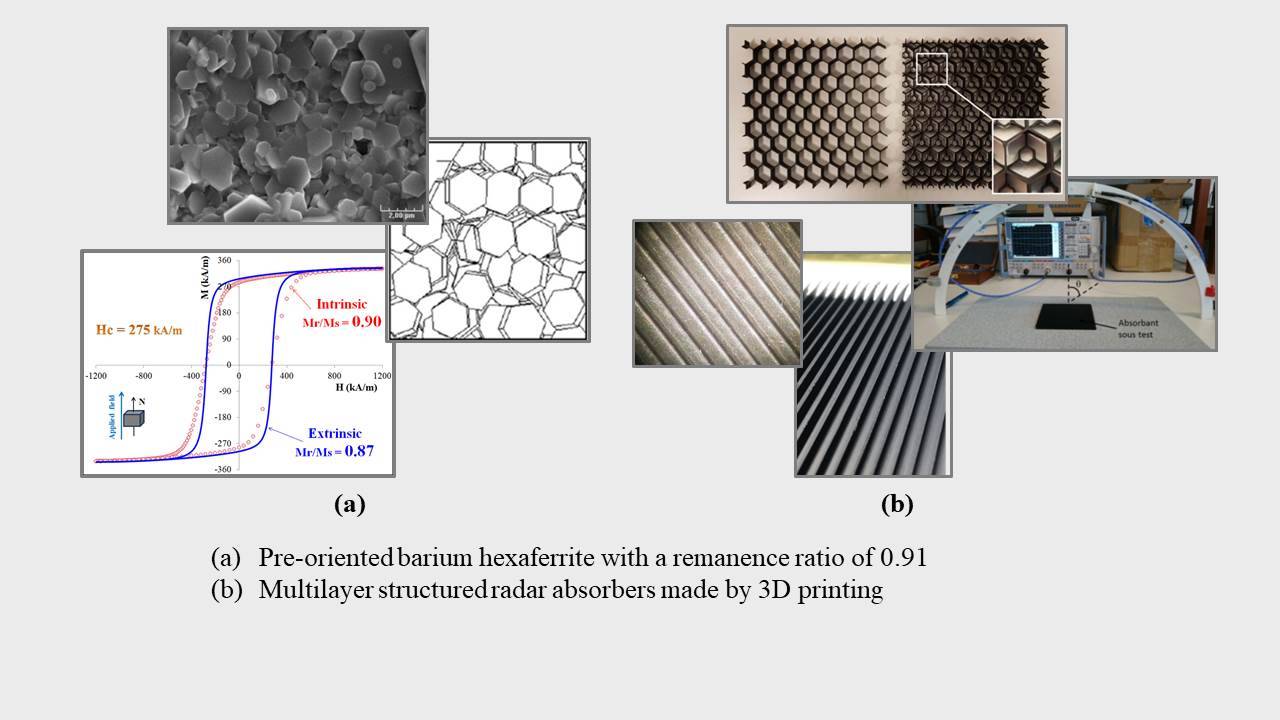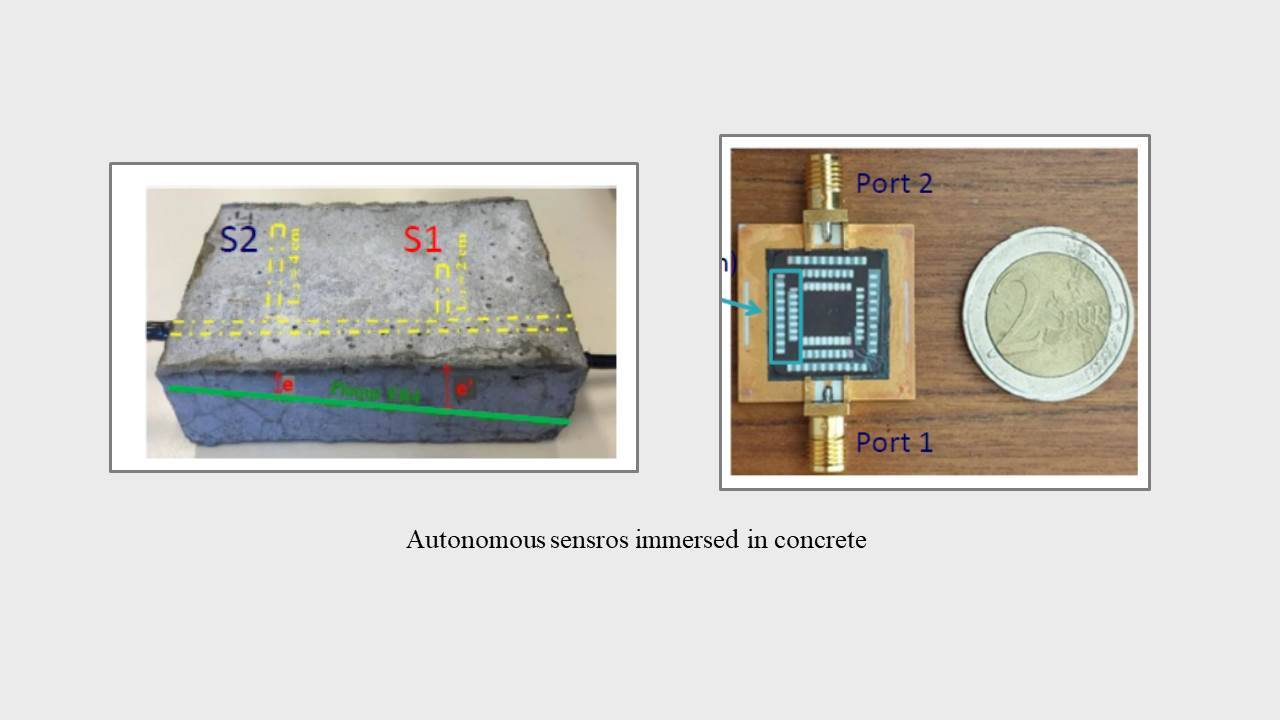The Smart Materials and Related Technologies (SMART) is focused on the interaction between electromagnetic (EM) waves and materials for different applications such as microwave devices and systems, biology or environmental sensors. SMART is consituted of 11 permanent members that have skills in physics, electromagnetism and electronics.
Our scientific activities focus on the following three areas of research:
1. Production and implementation of smart materials for microwave devices manufacturing processes
The team researchers produce low-cost magneto-dielectric materials with either chemical route or additive technology that allow them realizing and integrating magnetic ceramics (fabrication of low-loss magnetodielectric materials for microwave applications) as well as dielectric or magnetic polymer composites (patterned microwave absorbers, multi-materials, multilayers...). Magneto-dielectric materials, developed in the team, were used for the realization of compact tunable antennas in the VHF frequency band. The team activities on self-biased ferrites are at the state-of-the-art. The team is working on the elaboration of self-biased hexaferrites and on the modelling and integration of these materials in circulators and isolators in collbaboration with several industrial (Thales Alenia Space, Thales Research and Technology, Cobham Microwave, Thales LAS) and institutional partners (DGA, CNES, CEA, ESA) with the aim to decrease the size and cost of these devices. Outstanding results were obtained in the framework of european euripides MM_WIN project with the realization of an ultra-compact self-biased circulators in Q-band. During the last years, a new activity emerged in the team on the development 3D printable materials dedicated to microwave applications. This technology is applied to fabricate complex multi-materials multi-layers circuits and surfaces so as to propose an alternative to subtractive manufacturing. Fused Deposition Modeling of dedicated polymer composites was used to fabricate microwave loads and free-space absorbers in the framework of different projects (ESA ARTES AT, R&T CNES, CIFRE PhD). One of the activities of this axis also concerns the development and optimization of the properties of nanometric magnetic thin films (high permeability, high resonance frequency) for the miniaturization of microwave components. Finally, the members of the axis are working on the development of EM characterization methods for the extraction of properties (complex permittivity and permeability) of materials in different forms (liquids, solids, thin films) in frequency ranges from UHF to W band.

2. Electromagnetism of heterogeneous materials and biological structures
In this axis, the researchers of the team carry out numerical and experimental work on the study of complex heterogeneous media but also biological media.
On the theme of heterogeneous materials, the work concerns the modeling of the interaction between EM waves and polymer matrix nanostructures. The aim is to develop nano-structured assemblies with functionalities such as the appearance of magneto-electricity in magnetostrictive/piezoelectric nanocomposites. More recently, the characterization of multifunctional materials based on PVDF and P(VDF/TrFE) matrices loaded with carbon nanotubes (magnetically doped or not) or grapheme has been approached in order to model structure-property relationships but also to optimize technological solutions for electromagnetic shielding.
The members of this axis are also conducting multidisciplinary work on the electromagnetism of biological structures with the objective of linking the mechanical response of biological materials to an exogenous electromagnetic excitation. Preliminary simulations/experiments have demonstrated the relevance of a multi-scale statistical analysis based on core-shell models of cells. The adjustment of the excitation frequency of the field and the proximity phenomena allow to control the attractive or repulsive nature of the interactions between cells. This work is now oriented towards a multi-physics analysis in order to control the stresses and strains of elementary cells under the effect of the electric field. The development of high-frequency EP (Electroporation) techniques is favored because they open a way to gene therapies to modify the expression of a gene. Image reconstruction techniques developed in cooperation with our American colleagues at Virginia Tech. are used to make very realistic numerical models of tissues with which the calculations of field, deformation, pore density have been estimated. Tissue engineering experiments, in particular by 3D printing from suspensions of spheroids in gels (collagen, alginate, matrigel), reproducing the extracellular environment, in support structures are also studied to develop phantom structures to validate our numerical simulations.

3. Environmental sensors
A part of the team's activities concerns the elaboration and characterization of materials with the objective of electromagnetic modeling of elementary physico-chemical phenomena from very low frequencies to microwaves, leading to the development of sensors. This research theme is made possible by the skills of the researchers in the fields of materials science (elaboration by PVD, characterization by XPS, XRD, microscopy ...) and their broadband characterization. An important effort is focused on the characterization of electrical effects associated with the degradation of materials, allowing the development of sensors based on the propagation of radiofrequency waves. This research theme is strongly linked to the existence of local collaborations: Institute of Corrosion (Brest), IFFSTAR (Nantes), LEMAR (UMR 6539, Brest) as well as a strong interaction with the DH team of LabSTICC. This has resulted in collaborative projects CIFRE (Institute of Corrosion (Brest)), collaborative contract with IFSTTAR (Nantes), the regional project SAMM (Autonomous System in the Maritime Environment), the H2020 project SENSMAT (2019-2022), the ANR project CORSAIR (2020-2023).

